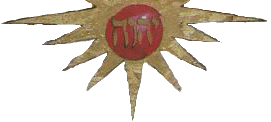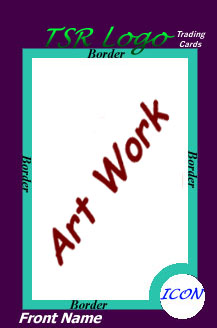


Please note that any TSR card scan here has been decapitated. I promise, it was a swift and painless surgical removal of the copyrighted TSR logo from the top. Ie, the various logos with the name of the series, such as Dragonlance or Greyhawk.
This page tries very hard to be anal! If you have any pertinent info not here, please e-mail me.
I suppose the above was an intro, but it wasn't very pertinent. That was more a legal issue. In any case, the TSR Fantasy Collector Cards (yes, that's the whole long name) ran from 1991-1993, meaning that there are three series, one for each year. The cards were made to feature the art of TSR games and books, as well as character stats and info. As you go through the cards, you'll definately recognize some of the characters and artwork, though some of the art appears to have been specially drawn for the cards. The 1991 series features more of our favorite characters and more of the book artwork. I'll try to be as precise and defining as I can, so if you're wondering why I go into such detail, it's both for you, and me.
I owe a great deal of thanks to Duane, for bringing to my attention many relevant and necessary facts. He encourages those interested in trading 1993 cards to e-mail him, or visit his web page.
About these cards:
These are examples from 1991, 1992, and the 1993 (of 495) card sets respectively. Click on them to see a larger version (a new feature for your modem happiness! :).
There are several little details you can note from these scans. One, note that only the last card, Tiyet, has a green background. All of these cards are characters, hence, they all have the helmet icon, that matches the border color.
The first two cards have a silver border because they are part of a factory set. Tiyet, however, has a ruby border. When you buy the cards in 1993 foil packs, you get mostly gold bordered cards, but sometimes you get a ruby one. See Borders and Icons, for more details.
These cards are the same size as baseball cards, but a little thicker. On both the front and back top of each card should be a logo. To the side of the logo, it should say "Trading Cards." Each picture of artwork is surrounded by a border; in the lower right front is the icon; bottom front left, the front name; and back lower left is the number. Back lower right is the copyright info. That's the basics, folks! (All terms in italics have their own section...well, they should.) See the images at the end for a visual summation of card parts and locations
The always accurate way to do this is to just look at the copyright info on the back, like this:


There are also several other details that help distinguish the years. 1993 was the only year with a green background, for example, and only 1991 checklists actually feature artwork on the front instead of tilted logos.
Now refer back to those cards again. The border is that thin line surrounding the artwork; don't confuse this with the background, which is the black or green part. The border is always the same color as the icon. Icons are those little things in circles in the lower right corner.
A factory set always has only silver cards. This is true of all the series of factory sets. Factory sets have all the cards in the set, rare and common (rare cards were just starting to come into vogue then ;), but the borders are silver. For some reason I'm not sure of, 1991 factory sets seem to be the easiest to aquire. You can frequently find them in Ebay auctions. However, please be wise!. Some auctioneers sell them for high prices, but most are low...if you find one that has a starting bid of 30 or above, chances are you can find a cheaper one.
Your other option is foil packs. You can also occasionally find these on Ebay in what some call "wax boxes", the display boxes that the packs came in. Each set was divided and sold in parts. The wax box I got once had only 1991 part one cards, 16 cards to a pack (Magic collectors realize this is a huge number!).
For the 1991 and 1992 set, the cards in foil packs were gold bordered, never silver bordered. This is also the case in 1993 foil backs, but with another nasty twist. See below:


Every card in the 1993 set of 495 has a ruby bordered doppleganger. Rubies are much rarer than golds, but the image is exactly the same.
Note: Border color is the same as icon color, irregardless of whether they're ruby, silver, or gold.
Icons: 3 icons, conveinantly constant throughout the three sets.
![]()
![]()
![]()
A crossed sword and axe (C), one a helmet (H), and the other a winged serpent (W), which I will, for the purposes of abbreviations, call a wyvern. H for Characters, C for Items, and the W is for Monsters.
The card number is located in a box, on the back, bottom left corner. In the 1991 AND 1992 series, there is only one set of 750, hence, only one number. However there are TWO sets in the 1993 series, one of 495, and one of 60.



In such a nit-picky page such as this one, the set of 60 (or chase cards), are rather hellish to describe. Most are color on the back side. The logo is in full color, as it is in the front side, and the box in the corner is a shade of green, as shown in the images. The back also has a kind of sheen to it, if you hold it to the light. However, there are some cards that ARE NOT colored on the back, but they do say "11 of 60" or something very similar.
It is also true that some of these chase cards are unnumbered! To know which number they are, you need the checklist for that set (which is either 1 or 60, I can't remember)
Often, the cards of the 1992 and 1993 sets are part of a mini series, like the Alliance of Defiance or Children of Darkness. Cards in mini-series often have like characteristics, like every card in the Children of Darkness mini-series have black and white artwork (See Tiyet at the top of the page). Mini-series is noted in applicable card lists.
Most of the time, the front name, the name on the front, bottom left of a card, is the same as the name, which is the largest heading on the back (except for checklists, which have no heading). However, there are some cases where this does not happen, especially with magic items. In fact, there is a card where the front name and the name are supposed to be the same, but the front name is mispelled (Kanag the Finder, front name: Knag the Finder). Consequently, my card lists reflect this.
Logos are the traditional TSR stuff, and are trademarks owned by that company. 'Tis against TSR online policy to display the copyrighted logos...I probably wouldn't get in trouble for doing so, but let's be nice here. ;)
Logos are located on the tops of both sides of a card. The one in the front is in color, like the picture, while the one in the back is usually in black and white, like the number box at the bottom. If the number box is green, ie, it is one of those cards in the set of 60 in the 1993 set, then the logo is in color too. Sometimes there isn't a number box, but the logo will still be in color because the back is in color, even if the text is still black on white. This is only in that particular set of chase cards, however. Logos are invariably black and white on the backs of every other card.
Of course, the logos represent which realm/world/fantasy locale the item/character/monster comes from. The following series are represented in the cards:
In the 1991 set, Al-Quadim is not listed as one of the series in the cards, and thus is NOT in the 1991 set. If you have a black-border Al-Quadim card, it comes from 1992. Dark Sun, which IS listed, has only ONE card, Neeva, fifth to the last. (Neeva also appears as part of the Women of Fantasy miniseries in the 1993 set).
De seguro, a person who is obsessive enough to come up with the amount of detail that's on this page, MUST, by simple human nature, have a list. Below are mine, though I warn you! These lists are not complete!
TSR Fantasy Collector Card List: 1991 Series TSR Fantasy Collector Card List: 1992 Series TSR Fantasy Collector Card List: 1993 Series

<-- Front
Back -->
 TSR's Home Page.
TSR's Home Page.
This page created and maintained by VASH.